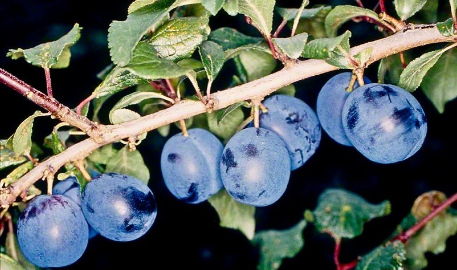

33. Langley Bullace - Damson

Season: - Quite late. Flowers in April, harvesting from Sept/Oct, but continuing on as long as November. It was considered traditional to pick
the fruit after the first frosts, which seem to concentrate the flavour.
Pollination: Self fertile. Group C

Despite its name this variety is best regarded as a small damson
Prunus insititia 'Langley'
The fruits are round to oblong and large for a bullace - more like a small damson than a true bullace - with blue-black bloomy skin.
The flesh is firm and green, with a clinging stone.
It has a sharp damson like flavour- too sharp for most people to eat fresh but good for culinary uses - stewing, bottling, pies, jam etc.
They were also traditionally used to make fruit wine.
The Langley Bullace is quite an odd looking tree. It's branches have a downward pointing habit as they emerge from the trunk, twisting upwards as they grow. Apart from that, it's a vigorous plant that becomes a heavy cropper when mature.
The name probably originates from the Old French beloce, meaning "sloe", to which they are related.
Wild plums were formerly given the related name "bullies" in parts of Lincolnshire. The similar word bwlas was used in the Welsh language.
The Langley Bullace, or "Veitch's Black Bullace", is by far the newest variety, being first raised in 1902 by the Veitch nurseries at Langley, Berkshire. It was a cross between an Orleans plum and the Farleigh damson, and is therefore not considered a true bullace in some sources. This is the largest variety, and when ripe - which occurs in November - is much the sweetest.



